Category Archives: Fish
Flukes in Marine Fish
One of the growing trends that I have seen (and experienced) is that flukes are becoming more and more common in the hobby. It used to be that fluke were more common on only certain types of fish, but more and more it seems that all fish can easily get them, or at least that has been my experience.
Flukes are a type of parasite with the broad group of gyrodactylus parasites. There are two common types of flukes, the ones that infect the skin of the fish (dactylogyrus trematodes), and the second that will infect both the skin and gills of the fish (monogenenean trematodes). Both can be very hard (if not almost impossible) to visually see on the fish until very advanced stages. While attached to the fish, they will feed on the tissues they are attached to. At some point they will start releasing eggs which will fall and lay dormant within the aquarium for about a week. They will hatch , releasing a free floating / swimming larva. This larva will survive for two or three days without attaching to a host before dieing. Typically the larvae will attach itself to either the gills or skin of the fish. Once attached, the larva will develop into a worm and releasing eggs continuing the life cycle. This final stage can last for about a week, maybe a little longer
Common Symptoms to look for:
The below list is the most common symptoms that you will find. You may notice one or many of the symptoms listed below:
1 Cloudy eyes
2 Rapid breathing
3 Fraid fins
4 Excessive slim coat production
5 Loss of appetite or even completely stopping to eat
6 twitching/shaking the head from side to side almost like it was trying to shake something off its head
7 discolored blotches on the fish which can even look a lot like velvet some times
8 Flashing against objects in the aquarium with periods of almost no activity
9 White to almost translucent spots on the fish that look almost like the ick virus, but are larger and not as close together.
Treatment Options:
1- Fresh water dips
While many hobbyists still successfully use freshwater dips, I do not like nor do I recommend fresh water dips. When completed incorrectly, they can cause more harm than good to an already sick fish. Additionally, with many of the new(er) medications available today that are a lot more effective and less harmful and less stressful to the fish, I feel fresh water dips are no longer required.
2- Treatment with medication in a QT set-up
This is my preferred method and is the one that I have obtained the most success with. I would recommend a treatment with Prazi-pro. This medication is safe to use in reef tanks with SPS corals and carpet anemones, and is also safe to be used in a QT set-up with copper based medications. However, they key to being able to successfully treating flukes is catching the symptoms early enough for the treatment to work. If the infection has spread to much through the gills, or the fish is no longer eating, you have a lower chance of successfully treating the fish. You also have to keep in mind, is that by treating a infected fish in a QT step-up or in a medicated treatment dip, you are not dealing with any of the parasite’s eggs that could be in your main tank waiting to hatch and infect / re-enfect your fish. You may have to consider treating your whole system.
The only caution to using prazi-pro in a display tank is that it will have an effect on worms (like flat worms) as well as some of the more sensitive filter feeders like coco-worms.
Preventative Measures
I always QT any fish I get before adding them to my display tank. As fish can carry flukes without actually becoming infected, I always use a preventative treatment of prazi-pro while in QT. While there are many medications out there that work on flukes, I have found prazi-pro works the best and it has the least side effects. Copper based medications will not work on flukes.
How did flukes get into my aquarium?
In short, they will have to be brought into your set-up by you. Typically they will get into your setup through:
1 An infected fish
2 On live rock from a infected set-up
3 On a coral form a infected set-up
4 In water added to your tank from an infected set-up
Poor water quality and / or environment stress will allow fluke to thrive and really take hold in your set-up.
Just a Word on Using Medications
1 Make sure your salinity is at least at 1.025 when using meds. All meds have a stronger than intended impact when used at lower levels of salinity
2 If treating with Praz-pro, remove your skimmer cup but leave the skimmer running. The use of praz-pro will make your skimmer go nuts. It will produce a truly amazing amount of bubbles like you have never seen before. You want to still have your skimmer running to keep the oxygen levels high in the water as some medications like praz-pro can lower the amount of oxygen in the water which is something you want to avoid.
3 Don’t forget to remove any type of carbon that you have running in your system
4 Fresh water dips will only remove the flukes from a infected fish, and not the flukes which are laying dormant within your set-up
5 Poor water quality and environmental stress will make most medications close to being useless
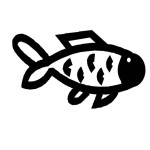
Responsible Fish Keeping
There certainly can be many conflicting opinions whether or not you can keep certain marine fish (most notably tangs) in certain sized aquariums. This can even become an emotional topic for many hobbyists. However, as the plural of anecdotal is not “fact”, I would challenge some of the commonly accepted facts / opinions that you read about on-line and further suggest to you to research these topics for yourself. In my opinion, completing your own research from credible sources is the only way to demonstrate responsible fish keeping though focusing on the facts. The below is a few examples of how I will approach keeping tangs to help give you better understanding of what I am talking about.
1) Proper Sized Aquarium
Don’t be fooled, conventional rules of thumb on tank size should not be considered a hard fast rules, but only used as a starting point to determine proper tanks size. That is why most people state tank sizes as “minimum aquarium size” and not as “ideal aquarium size”. I have seen tangs which appeared to do well in a 120 gallon tank for many years, and yet I have seen the same type of tang suffer to the point of eventually dyeing in a 230 gallon tank. So which tank is was the correctly sized one? And just to make matters a little more complex, different tangs have different requirements so you do have to keep in mind, not all tangs will have the same needs. How long and wide a tank is along combined with how much swimming space they would need is what you will need to determine in order to find a properly sized tank for the specific tang you would like to keep. I have always found the amount of open swimming space was one of the most critical factors to think about. Having a tang in properly sized tank will do no good if you use up the space in the tank by placing large amounts of rock and/or large amounts of tall corals. In the example I just mentioned above, the 230 gallon aquarium had far too much rock in it (at least in my opinion) and had a lot of extremely large SPS corals which limited the amount of swimming space to less than what was in the 120 gallon tank. That is why I choose to stock based on the open swimming space (open water area) within the tank after I have all my planned rock and corals in there. I will typically refer to published research papers and books written by credible authors in the field when determining the proper aquarium size and swimming space required.
2) So how big will my tang get?
Many sites will list the maximum scientifically measured size of a fish as their adult size. I think it is more realistic to look at the average size of a fish. After all, the tallest person in the world was well over 9 feet tall, yet all of the doorways into our homes we build today are around 7 feet with around 8 to 9 foot tall ceilings inside the home. This doesn’t mean you or I were stunted by our home, just that we are closer to average height as compared to the tallest person in the world. There are a few other factors that also make the average size of a fish size as a better approach to use
– In the wild the more dominant male, or “super male” will tend to get larger than normal which will not occur within a home aquarium
– Fish will not get as large in captivity as they do in the wild. I have read studies that showed fish in captivity typically get to between 66 and 80% of the normal or average size in the wild. These same studies also concluded these same fish were not stunted due to their: healthy appearance, normal behaviors, and long life span.
Once again, I will typically refer to published research papers and books written by credible authors in the field when determining how big a fish will become over time.
3) What about keeping multiple tangs?
For long term success, you should either keep a single tang, or a group of around 5 or more assuming your tank size and filtration can accommodate them. Many different types of tangs will typically not tolerate other tangs of the same species or a species that look very similar to themselves, while others can be just plain bullies. You will always have at least a small element of risk with keeping multiple tangs as these fish can be a lot like people, each with their own personality and disposition. Sometimes you can complete more than enough research but you just won’t know for sure how it will work out until you try it. Just be prepared to watch carefully and react quickly should things not work out the way you expected. Once appropriate tank size, fish size, and swimming space has been validated, you will need to determine what type of territorial needs each fish has if you are keeping more than one, and what would be the best approach to take when adding these fish to your set-up. I would include all fish (and not just tangs) into this part of the process.
Many have suggested keeping tangs in odd numbers, like 5 or 7. I have often wondered about how important this actually is, after all, can tangs count? I would guess the most critical element would be to keep them in higher numbers, the more the better (assuming you are not overstocking the tank as already mentioned). However, I will typically refer to published research papers and books written by credible authors in the field when considering keeping multiple tangs in a single aquarium.
4)Are there other things to consider ?
Putting all personal opinions aside, we can all agree that good aquarium husbandry will be just about the most important aspect of keep in any fish. The two other critical elements that will also have to be considered are:
1) Water parameters
2) Diet
This can be just about the easiest part of your research to complete. As the tangs that I keep come from the in or near our coral reef, I try to keep the water parameters as close as that of the coral reefs as I can. The below link can explain that in a little more detail. The proper diet is also fairly easy to identify with a little research from published research papers and books written by credible authors in the field.
https://www.reefaquarium.com/2013/the-basics-of-marine-aquarium-water-parameters/
5) How do I know when I have made the correct choices?
When you have completed the proper research, things should be going great and you will be enjoying your aquarium for years to come. So, what does it look like when things are going good? Basically, you should have a healthy fish that looks and acts normal. The below list are just a few things that will give you a indication when things are going well:
-No signs of chronic disease.
-No signs of abnormal coloring or body shape.
-No signs of abnormal behavior.
-Strong appetite when offered a proper diet.
-No signs of abnormal stress, which is typically shown as higher than normal respiration rates.
There can be many different signs to watch for which can be a indication that you may not be providing a proper home for your tang, or any other type of fish as well. You can take the list above and watch for the opposite. However, there are a few other things to watch for that could be a indication your fish is in a aquarium that is too small. These things can include:
-Bruised nose.
-Bent or torn fins.
-Shortened life span.
I’m not trying to make things seem more complicated for you when trying to determine proper aquarium size and environment for your planned fish. I just want to give you some guidelines to think about when completing this research for yourself based on what I have learned completing my own research along the way. There is a lot of information available on line and in forums, but not all of it is good. You need to be able to find credible information from experienced people and start form there. The better quality information that you find, the easier the research will become and you will have a better and healthier aquarium because of it.
Some additional references:
http://coralmagazine-us.com/content/arrested-tang-police-i-refuse-confess
http://microcosmaqx.typepad.com/jay_hemdal/2009/01/beware-the-tang-police.html
http://www.tfhmagazine.com/saltwater-reef/feature-articles/putting-fish-back-into-the-reef-tank.htm
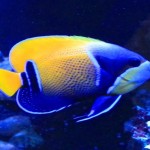
Majestic Angelfish
Common Name: Majestic Angelfish, Blue Gilled Angelfish
Scientific Name: Pomacanthus Navarchus
Reef Safe: No
Temperament: Semi-Aggressive
Care Level: Moderate
Max Size: 12 to 14 inches (8 to 10 is more common)
Appearance:
This is a very colorful angelfish. It has a yellow color with darker blue markings on the body and a blue band on the head which included the eyes. There also will be a light blue edging that will separate the dark blue and orange coloring on most of this fish’s body. The fins are also blue with a lighter blue to orange like boarder around the edges.
Juvenile majestic angels will have a different appearance. They will have a black to dark blue colored body with orange to yellowish to orange tint or undertone to the color which shows under certain lighting conditions. Their bodies will also have vertical stripes that are more of a light blue color with a very slight orange tint to them as well.
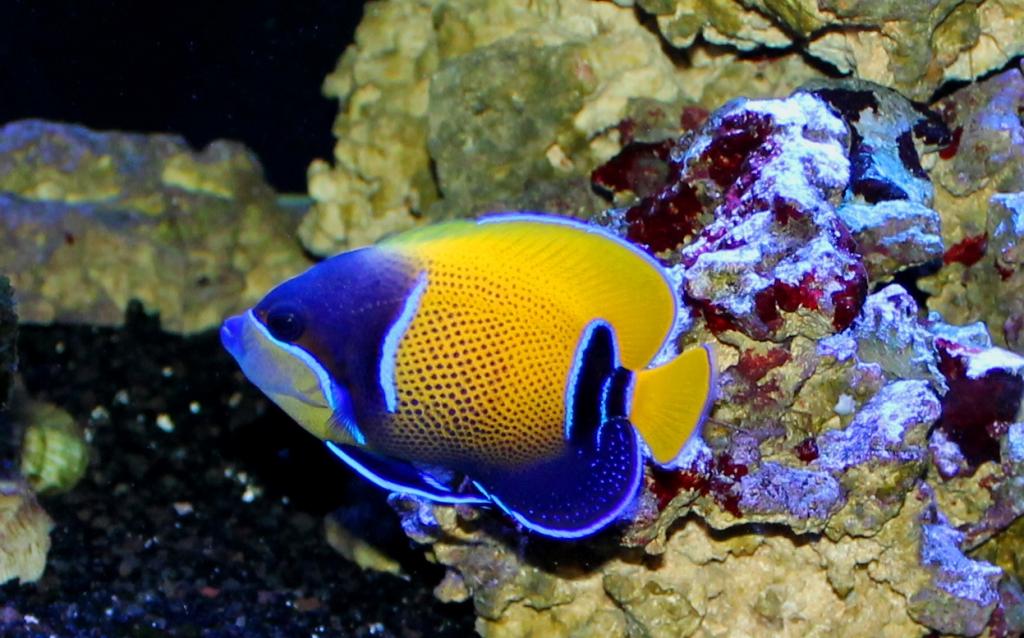
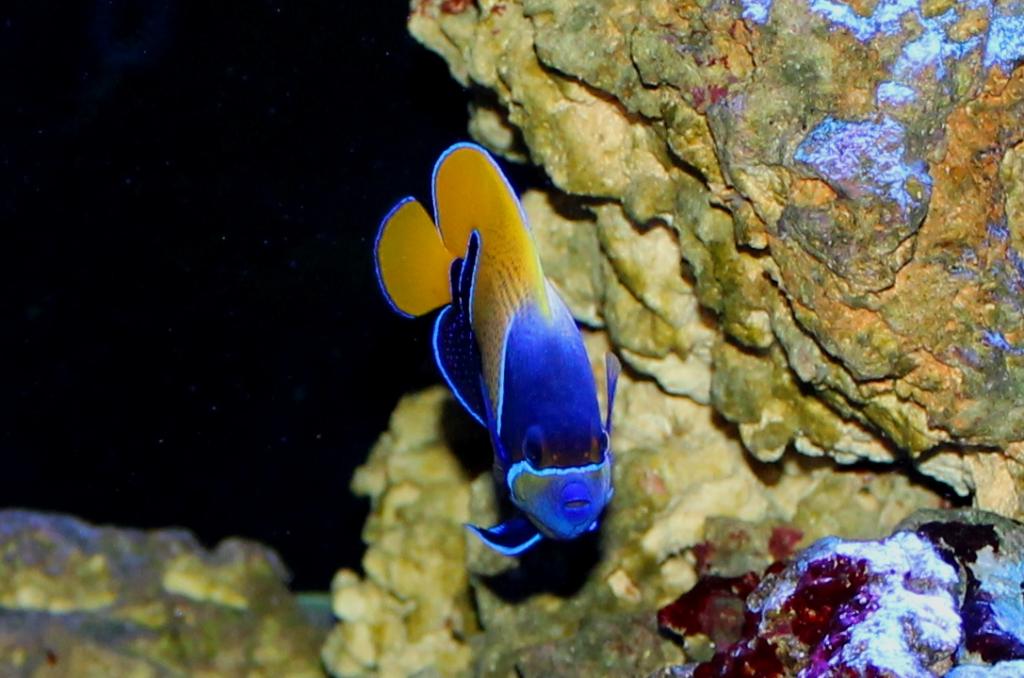
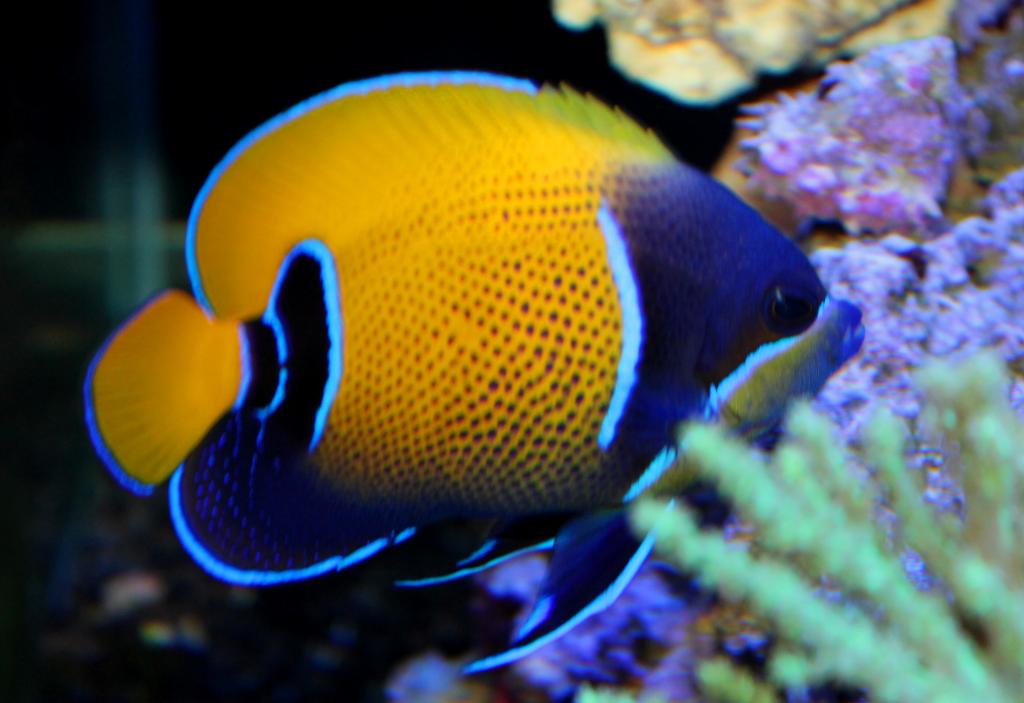
Temperament
This can be a territorial fish and should be kept as the only majestic angelfish in an aquarium. It should not be kept with other territorial fish or other angels. They have been known to nip at clam mantels and, in rare cases, anemones as well. They will do best in a FOWLR set-up with other peaceful fish or a reef tank with SPS corals.
Environment
This fish will need at least a 120 gallon FOWLR set-up with many hiding spots appropriate for its fully grown size. As they can be very sensitive to water quality, it would be best to introduce this fish to a matured set-up. They will also need large amounts of live rock to pick at as well as hid in.
Recommended water conditions:
I would refer you to the below article for the typical water conditions that a Majestic Angelfish will do best in. As with most of the larger bodied angelfish, they need very good and very stable water conditions for long-term success.
https://www.reefaquarium.com/2013/the-basics-of-marine-aquarium-water-parameters/
Diet
This angelfish (as with most angelfish) are omnivores. They can be picky eaters making them difficult to switch them over to frozen and flake or pellet foods.
Once they start eating, they will accept almost any food you may offer it. However, they are omnivores and will require a diet consisting a good amount of algaes with some other verities of meaty foods and foods containing sponges as well. A good quality flake or pellet food meant for marine angel fish that contains the same nutrients as sponges is also a good option for the their main diet.
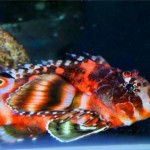
Fu Manchu Lionfish
Common Name: Fu Manchu Lionfish, Ocellated Lionfish, Twinspot Lionfish
Scientific Name: Dendrochirus Biocellatus
Reef Safe: Yes
Temperament: Predator, but peaceful in the right set-up
Care Level: Moderate to difficult
Max Size: 4 inches
Appearance:
The Fu Manchu is among the more interesting and beautiful of the dwarf lionfish. It has very vibrant and contrasting colors of black brown, red and white. The Fu Manchu also has a unique feeler like tentacles at the corners of it’s mouth.
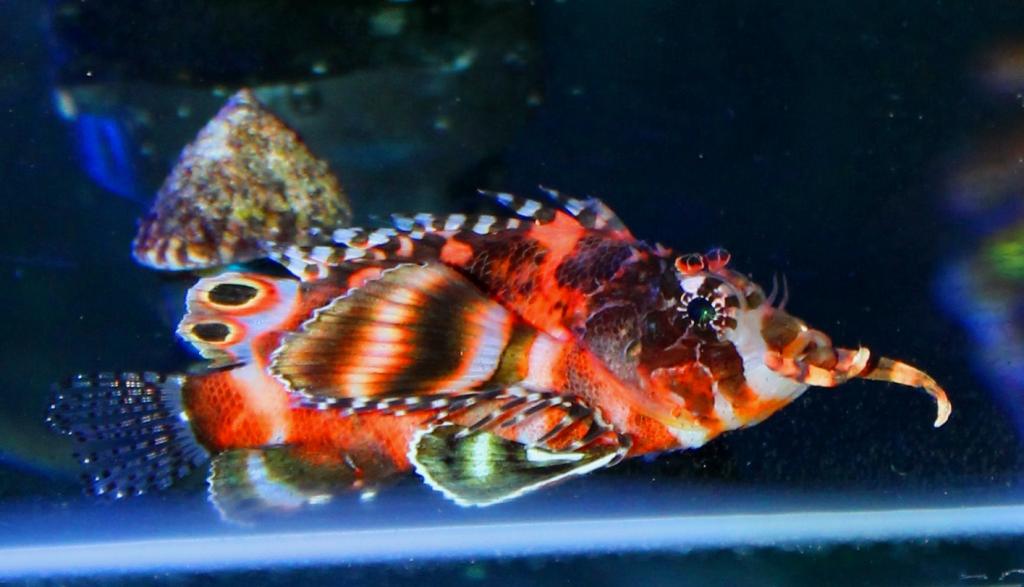
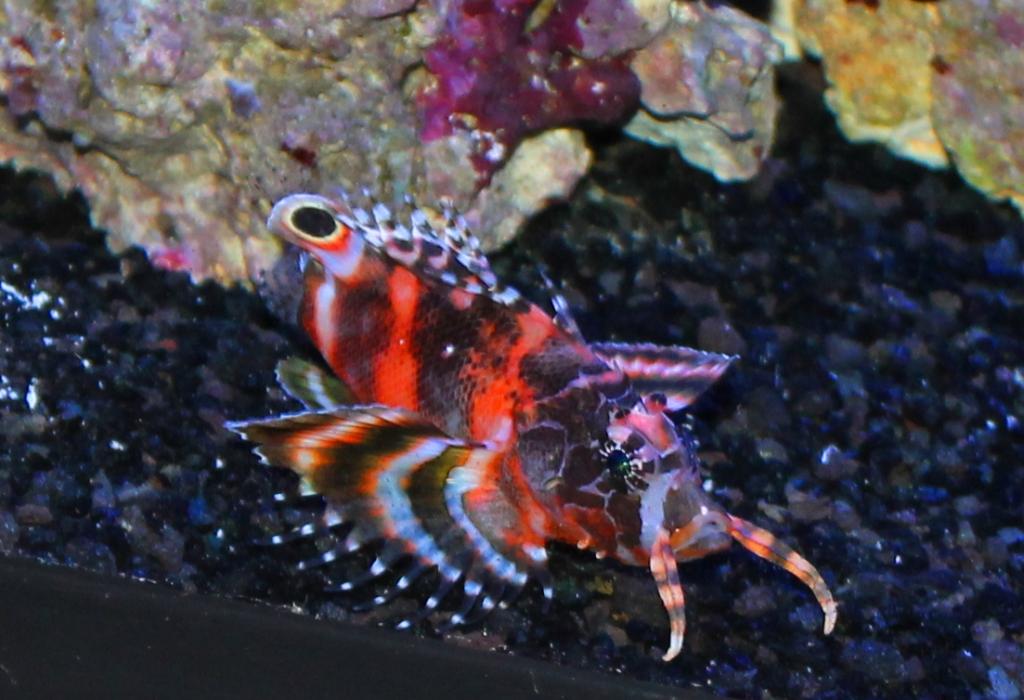
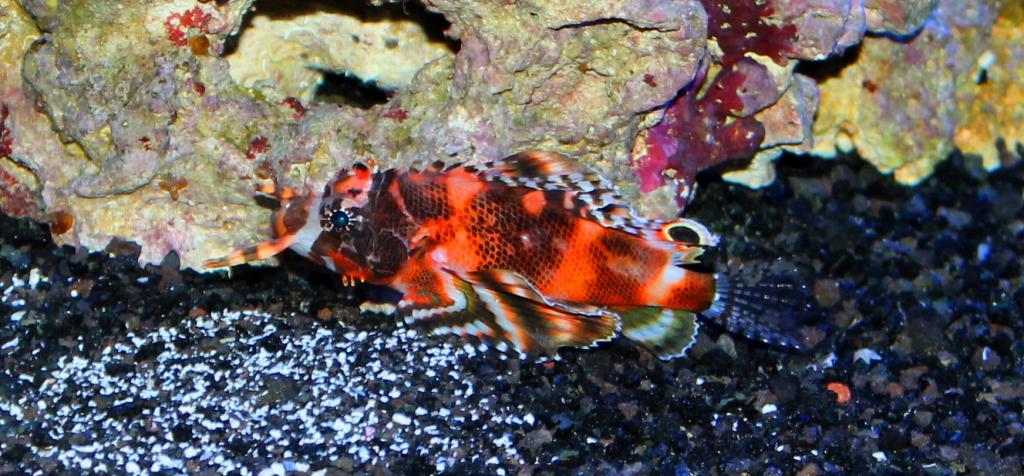
Temperament
They will do perfectly fine with other fish of similar size and can be a very peaceful community fish when kept with the correct tank mates. They can be a very shy fish that will not do well with other semi-aggressive fish. However, when kept with fish that have a body size of about ½ of the lionfish’s body size; it will only be a matter of time before the Fu Manchu lionfish will try to eat it. They are among the better predators common in the hobby. Although you can keep multiple Lionfish in the same aquarium, you should use caution when doing so. You would need to ensure they are both a very similar size and added at the same time to increase your chances of success. One of the Lionfish can become very dominant and will bully the others steeling all the food when you feed the tank.
Environment
I would suggest a 36 inch long, 30 gallon aquarium would be the minimum size for the Fu Manchu lionfish based on its potential fully grown size. They need swimming space both around rocks and out in the open. They do best when provided shelf like structures which they can hang up-side from as well as cave structures they can sit in. This lionfish can be kept with corals. They have been known to eat smaller fish and shrimp (members of a tank’s cleanup crew) which cause many people not to add them to a reef aquarium.
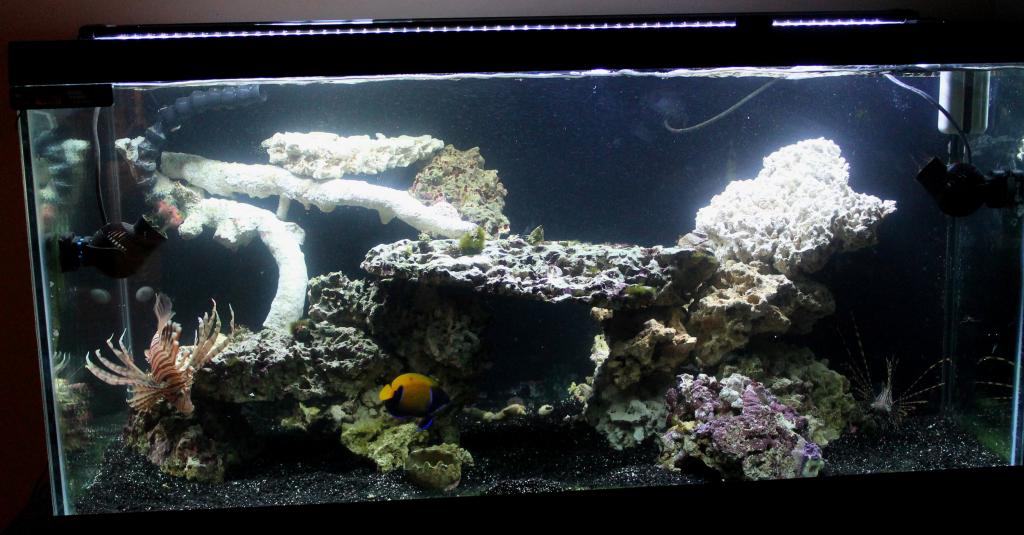
Recommended water conditions:
I would refer you to the below article for the typical water conditions that a Fu Manchu lionfish will do best in. As a more difficult fish to keep, the Fu Manchu will also need both good and stable water parameters for long term success.
https://www.reefaquarium.com/2013/the-basics-of-marine-aquarium-water-parameters/
Diet
These predators are naturally carnivores. Getting this Lionfish to eat a healthy diet for it’s long term health is one of the biggest reasons for hobbyist having difficulties keeping lionfish. As the Fu Manchu lionfish is a predator, they are used to eating live fish that are anywhere about ½ their body size or less. It can be difficult to get them to switch to eating meaty frozen foods and/or pellets for marine carnivores.
I have had great success by using a very long pair of tweezers to take a smaller and longer peace of frozen food and wiggling it in the aquarium near the lionfish. This makes it look alive and the lionfish will typically eat it after a few days to a week of trying. Other hobbyist has also had great success with this approach by sticking the food on a small wood stick (like you use to make shish kabob). Once they are eating the wiggling food and have gotten used to it, I will start to wiggle the food less and less slowly getting them used to eating food that doesn’t look alive. Once they are at this point, you can just add the food to the tank and they will “hunt” it down and eat it. This is why I always suggest buying a lionfish that is already eating frozen foods so the above process will be a lot easier for you.
The above process is a proven one that works. Many people get frustrated and give up trying only to offer the lionfish live foods like small feeder goldfish. I do not recommend feeding your lionfish feeder goldfish for two reasons; 1) freshwater fish to not have the same mineral and fatty tissues that marine fish have which will not provide the lionfish with the proper nutrients it will need for long-term health, and 2) The lionfish will always favor live food over frozen as that is instinctive to them. This will set-back your efforts to get the lionfish to eat frozen foods. I would not even offer a lionfish live foods as the occasional treat.
Once you get your lionfish eating frozen foods, they will need a variety of different meaty foods like: prawns, large Mysis shrimp. The below thread will give you some better ideas for feeding a lionfish a diet that will help them have along and healthy life in your tank.
Be careful not to overfeed a lionfish as they have been known to overeat to the point of creating an internal blockage if given the chance. Just feed enough until you see a slight bulge in their stomach. Feed every second day as juveniles and about three times a week as adults.
https://www.reefaquarium.com/2012/feeding-high-quality-froozen-foods/
Special considerations
1) Feeding by hand
I never recommend feeding your lionfish by hand. Although they will readily take the food form you, over time they will learn to associate your hand with feeding. When you try to put your hands in the tank for reasons other than feeding, the lionfish will still think they are about to get fed and swim up very close to your hand. That can put you at some risk of getting bit or stung depending on the exact personality of your lionfish
2) Venomous Spins
The long dorsal fin of the lionfish contains venomous spins. If you get stung by one, it is going the hurt a lot like a very bad bee sting, or at least that is what I have heard. If you get stung by one, soak the stung part in hot water (as hot as you can stand it) for about 15 or 20 minutes. If you see any signs of a allergic reaction, seek medical attention immediately. I have found the best way not to get stung (accidentally or otherwise) is to make sure you do not spook or corner the lionfish when you put your hands in the tank
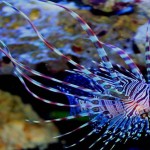
Volitan Lionfish
Common Name: Volitan Lionfish, Colored. Black Volitan Lionfish
Scientific Name: Pterois volitans
Reef Safe: Yes
Temperament: Predator, but peaceful in the right set-up
Care Level: Moderate
Max Size: 11 to 14 inches (refers to the body size excluding the fins, around 12 inches is more common)
Appearance:
This is one of bigger of the larger bodied lionfish. They have all the typical fins as with any of the larger lionfish. The coloring of their stripes will be brown to dark brown in color. It can be easy to mistake a Russels Lionfish with a volitan lionfish if you do not know what to look for. There are three key differences to look for. 1) The tailfin will have spots on it while the Russels will not2) The Russels bottom jaw and chin will also be white which while the volitan will have a color pattern on the bottom jaw 3) The spins along the dorsal, pectoral and anal fins on a russels lionfish are not banded and more fleshly in appearance while these same fins on a volitan are more sleek in appearance and will have dark colored banding on them.
The below pictures are of my black volitan lionfish about 5 months after I added him to my tank
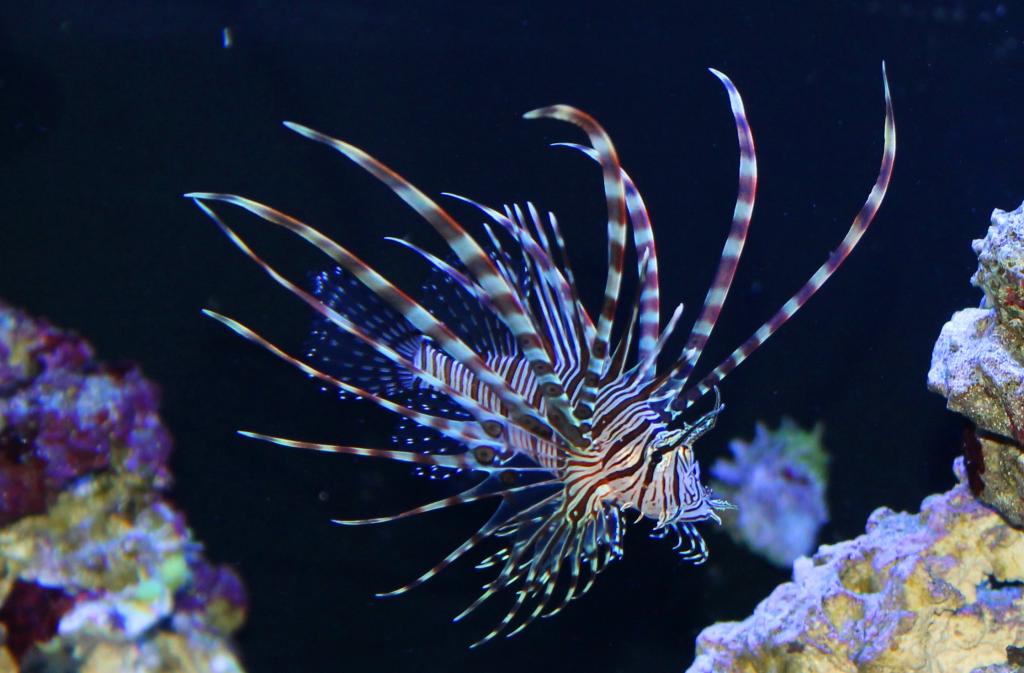
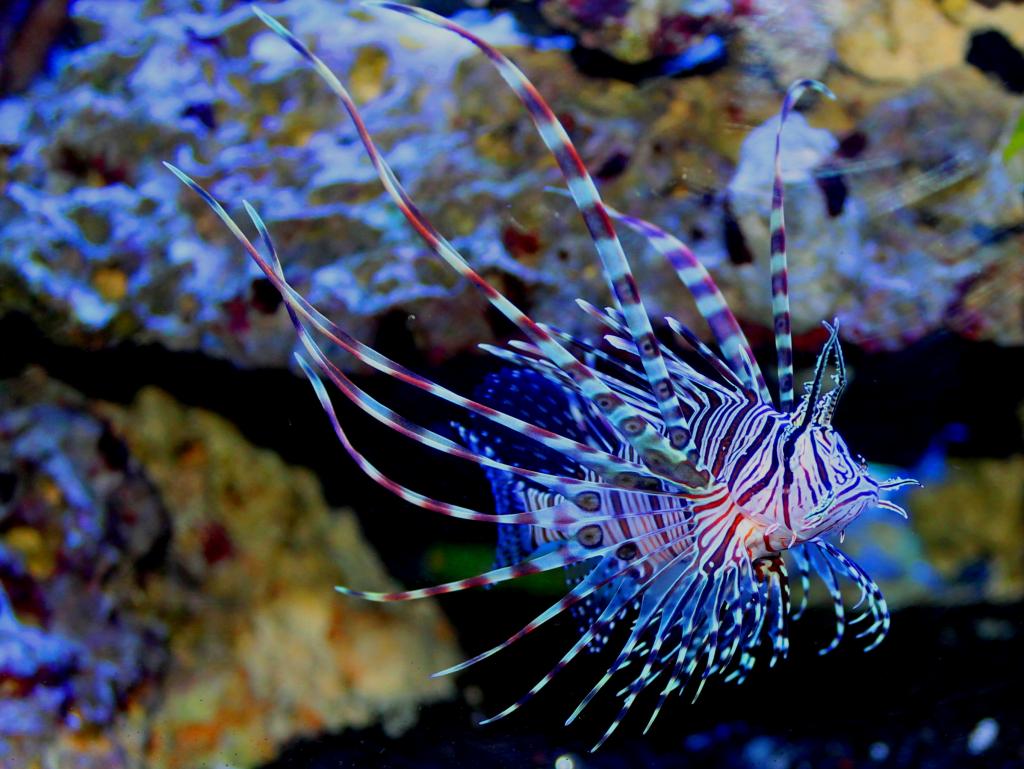
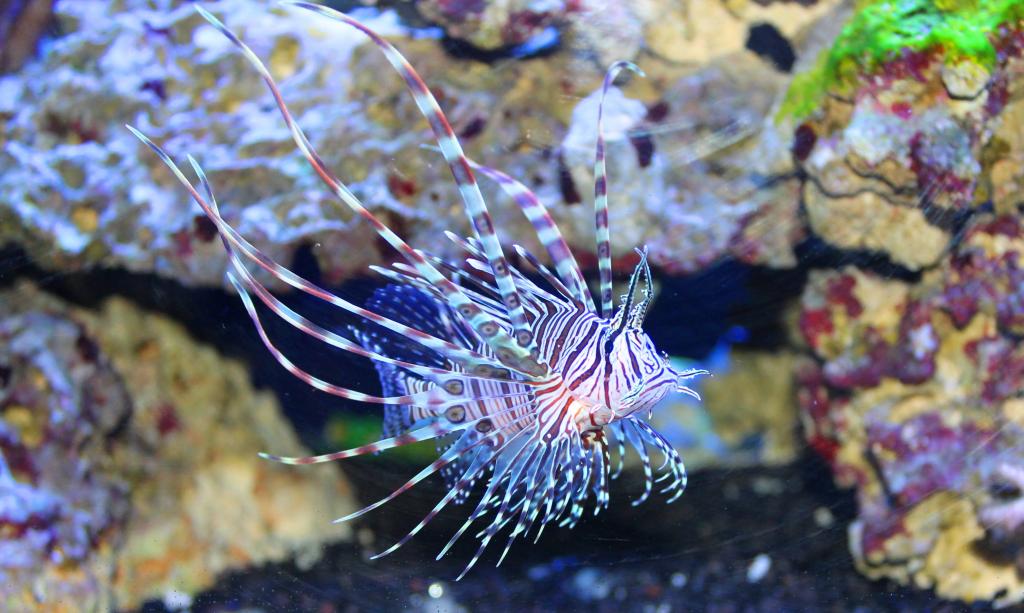
The below pictures are of the same lionfish 3 years later
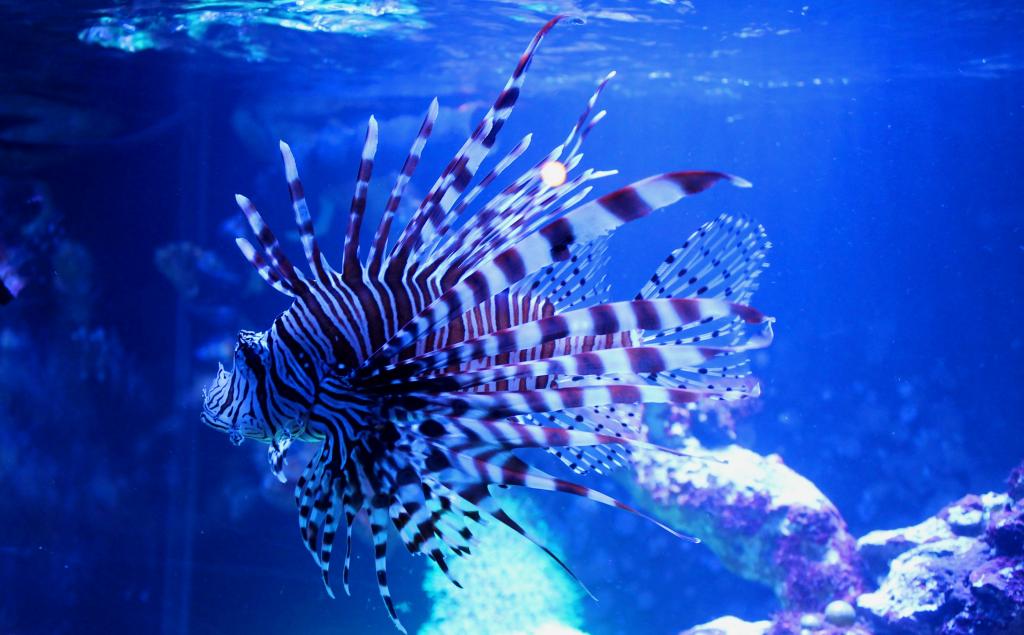
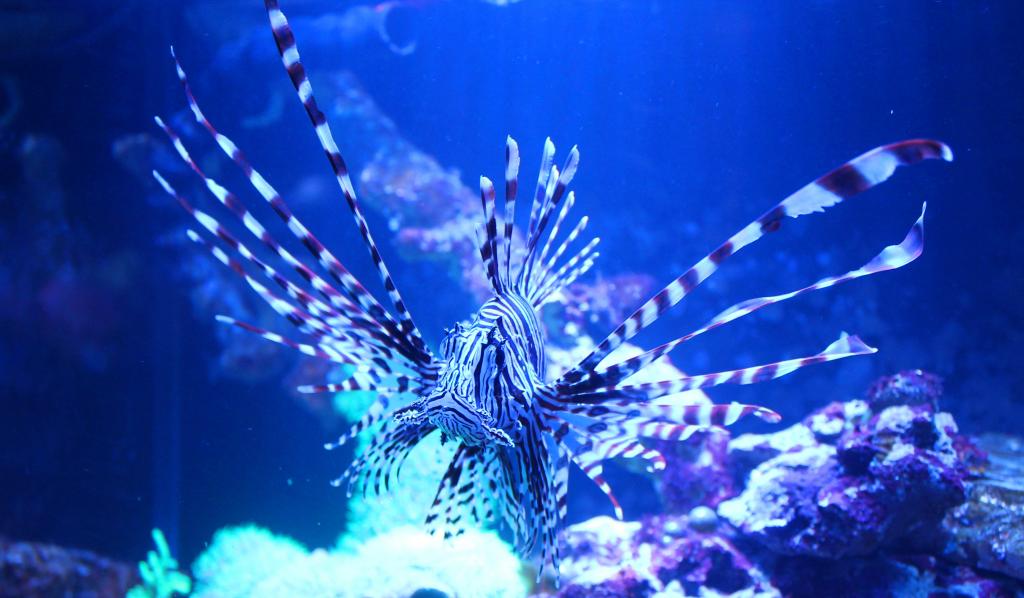
Temperament
They will do perfectly fine with other fish of similar size and can be a very peaceful community fish when kept with the correct tankmates. However, when kept with fish that have a body size of about ½ of the lionfish’s body size; it will only be a matter of time before the volitan lionfish will try to eat it. They are among the better predators common in the hobby. Although you can keep multiple Lionfish in the same aquarium, you should use caution when doing so. You would need to ensure they are both a very similar size and added at the same time to increase your chances of success. One of the Lionfish can become very dominant and will bully the others steeling all the food when you feed the tank.
Environment
I would suggest a 120 gallon aquarium (24 inches wide) would be the minimum size for the volitan lionfish based on its potential fully grown size. They need swimming space both around rocks and out in the open. They do best when provided shelf like structures which they can hang up-side from as well as cave structures they can sit in. The below is an example of both. Lionfish can be kept with corals. They have been known to eat smaller fish and shrimp (members of a tank’s cleanup crew) which causes many people not to add them to a reef aquarium.
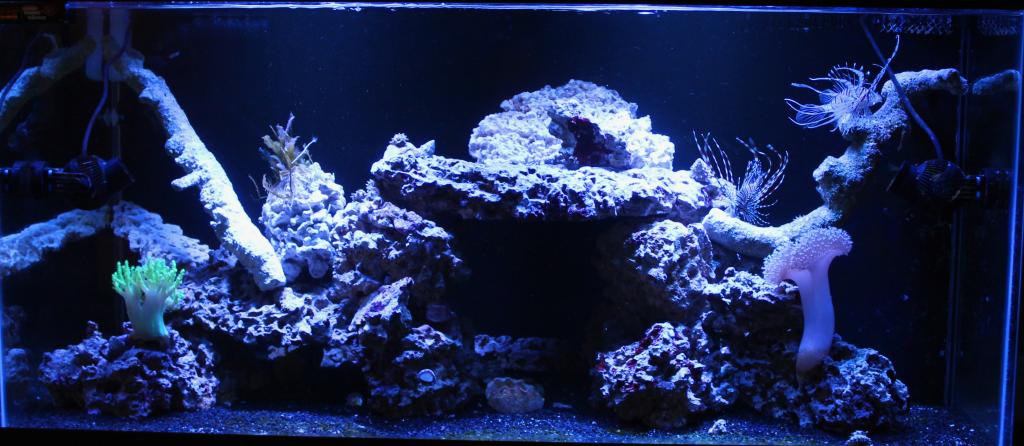
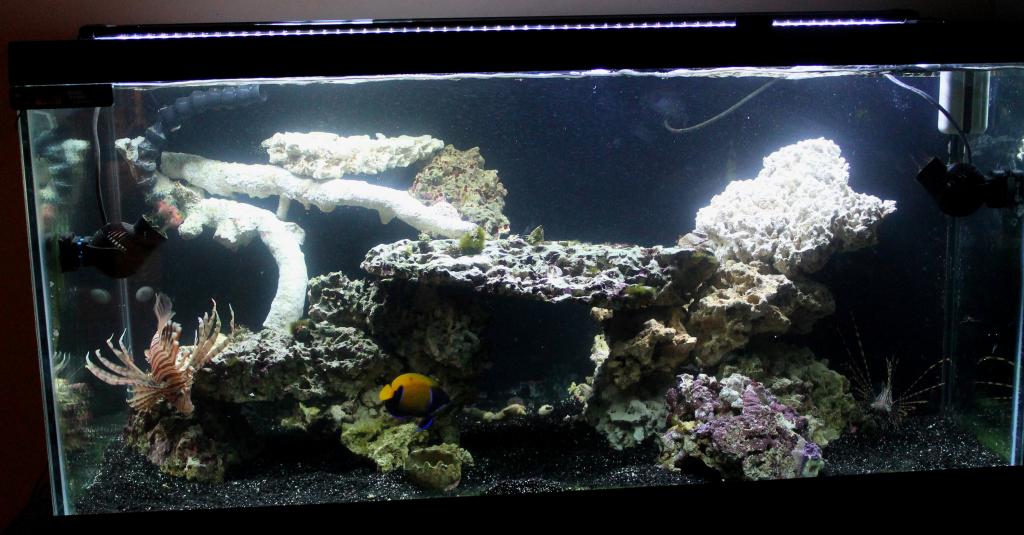
Recommended water conditions:
I would refer you to the below article for the typical water conditions that a volitan lionfish will do best in:
https://www.reefaquarium.com/2013/the-basics-of-marine-aquarium-water-parameters/
Diet
These predators are naturally carnivores. Getting this Lionfish to eat a healthy diet for it’s long term health is one of the biggest reasons for hobbyist having difficulties keeping lionfish. As the volitan lionfish is a predator, they are used to eating live fish that are anywhere about ½ their body size or less. It can be difficult to get them to switch to eating meaty frozen foods and/or pellets for marine carnivores.
I have had great success by using a very long pair of tweezers to take a smaller and longer peace of frozen food and wiggling it in the aquarium near the lionfish. This makes it look alive and the lionfish will typically eat it after a few days to a week of trying. Other hobbyist has also had great success with this approach by sticking the food on a small wood stick (like you use to make shish kabob). Once they are eating the wiggling food and have gotten used to it, I will start to wiggle the food less and less slowly getting them used to eating food that doesn’t look alive. Once they are at this point, you can just add the food to the tank and they will “hunt” it down and eat it. This is why I always suggest buying a lionfish that is already eating frozen foods so the above process will be a lot easier for you.
The above process is a proven one that works. Many people get frustrated and give up trying only to offer the lionfish live foods like feeder goldfish. I do not recommend feeding your lionfish feeder goldfish for two reasons; 1) freshwater fish to not have the same mineral and fatty tissues that marine fish have which will not provide the lionfish with the proper nutrients it will need for long-term health, and 2) The lionfish will always favor live food over frozen as that is instinctive to them. This will set-back your efforts to get the lionfish to eat frozen foods. I would not even offer a lionfish live foods as the occasional treat.
Once you get your lionfish eating frozen foods, they will need a variety of different meaty foods like: prawns, large Mysis shrimp. The below thread will give you some better ideas for feeding a lionfish a diet that will help them have along and healthy life in your tank.
https://www.reefaquarium.com/2012/feeding-high-quality-froozen-foods/
Be careful not to overfeed a lionfish as they have been known to overeat to the point of creating an internal blockage if given the chance. Just feed enough until you see a slight bulge in their stomach. Feed every second day as juveniles and about three times a week as adults.
Special Considerations
1) Feeding by hand
I never recommend feeding your lionfish by hand. Although they will readily take the food form you, over time they will learn to associate your hand with feeding. When you try to put your hands in the tank for reasons other than feeding, the lionfish will still think they are about to get fed and swim up very close to your hand. That can put you at some risk of getting bit or stung depending on the exact personality of your lionfish
2) Venomous Spins
The long dorsal fin of the lionfish contains venomous spins. If you get stung by one, it is going the hurt a lot like a very bad bee sting, or at least that is what I have heard. If you get stung by one, soak the stung part in hot water (as hot as you can stand it) for about 15 or 20 minutes. If you see any signs of a allergic reaction, seek medical attention immediately. I have found the best way not to get stung (accidently or otherwise) is to make sure you do not spook or corner the lionfish when you put your hands in the tan
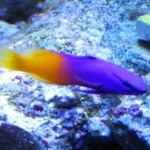
Royal Gramma
Common Name: Royal Gramma, Royal Gramma Basslet
Scientific Name: Gramma Loreto
Reef Safe: Yes
Temperament: Peaceful
Care Level: Easy
Max Size: 3 inches
Appearance:
The royal gramma is a very colorful little fish and will bring a lot of color and activity to any adequately set-up aquarium. The front half of the fish is a very bright purple color while the back half of the fish is a vibrant yellow color. The royal gramma will also have some dark markings near it’s eyes.
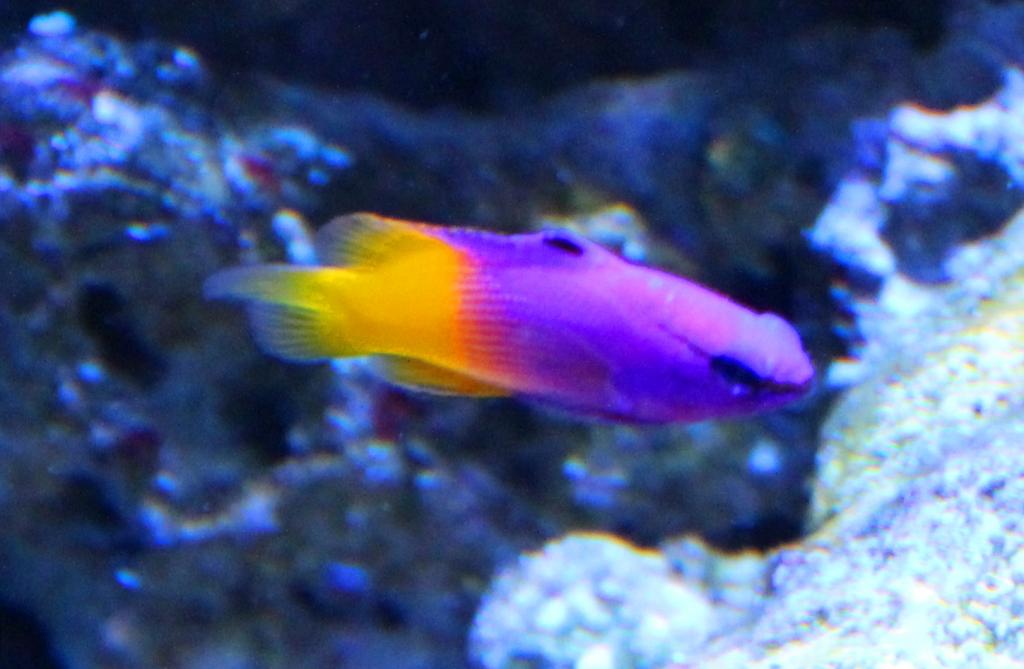
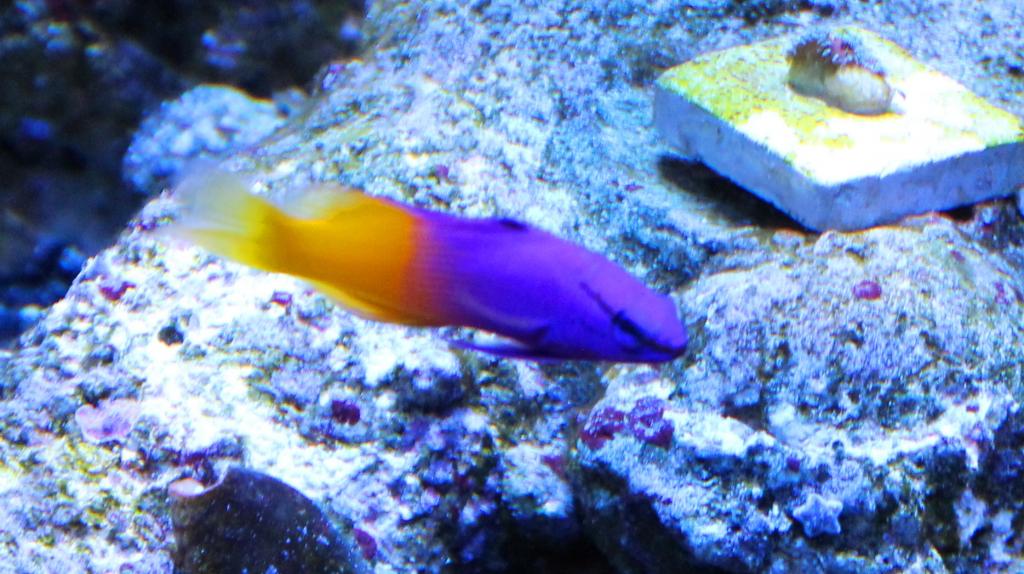
Temperament
Royal grammas are a very peaceful fish to have in an aquarium. You can keep them with any other peaceful fish . It is not recommended that you keep more than one royal gramma in your aquarium as they will get territorial and aggressive towards other royal grammas.
Environment
I would suggest the best minimum aquarium size for a royal gramma would be a standard 36 inch long 30 gallon tank Some hobbyists have claimed long term success keeping a royal gramma in a 29 gallon bio-cube. As they will need hiding spots, I would suggest an aquarium with a good amount of live rock which can provide them with at least a few cave like spots to hide in.
Recommended water conditions:
I would refer you to the below article for the typical water conditions that a royal gramma will do best in:
https://www.reefaquarium.com/2013/the-basics-of-marine-aquarium-water-parameters/
Diet
Royal grammas are carnivores, A diet consisting of a verity of meaty foods such as brine shrimp or mysis shrimp (as two examples) would be good options. The royal gramma would also benefit from a good quality marine flake food for carnivores.
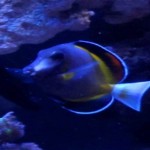
Powder Brown Tang
The below profile is on another one of the interesting tangs that I have kept. This information Powder brown Tangs is based on what I have learned and observed.
Common Name: Powder Brown Tang
Scientific Name: Acanthurus Japonicus
Reef Safe: Yes
Temperament: Peaceful for the most part
Care Level: Moderate
Max Size: 8 inches (around 6 inches is more common)
Appearance:
The powder brown tang has the typical oval shaped body, just as with most other tangs. As the common name suggests, it has brown coloring on its body. There are white marks on both cheeks as well as near the eyes and mouth. The fins are typically a darker shade of brown when compared to the brown on the body. The fins will also have a lighter blue colored highlights around the edges. The tail fin will have a little different coloring having a strong blue undertone to it as well as a yellow vertical bar. There will also be a yellow strip along the body separating the body and fins.
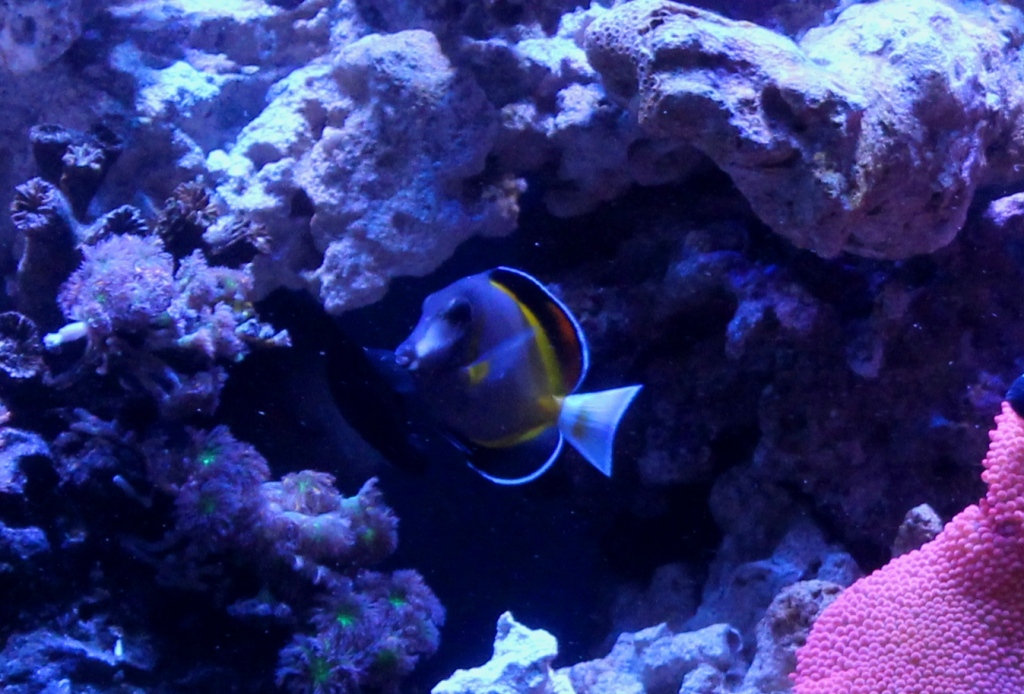
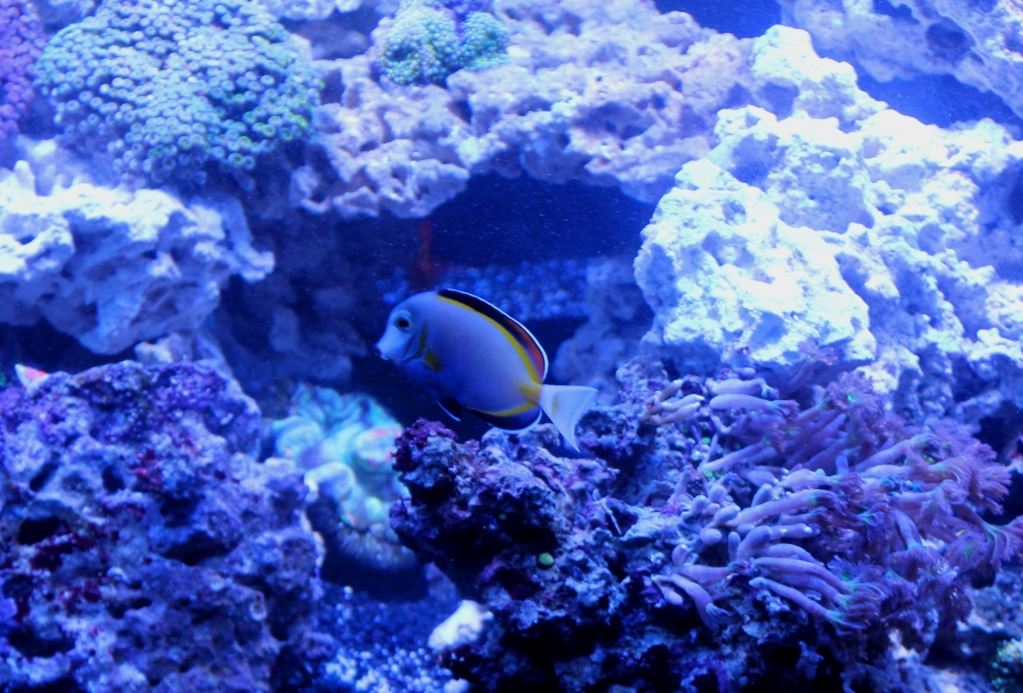
Environment and Temperament
Powder brown tangs can become semi-aggressive when kept with other tangs of a similar shape, size, and color to them and can also become aggressive with other powder brown tangs in the same aquarium. This behavior can actually be fairly common with most tangs. The powder brown tang however is a great fish for a community tank as they will peacefully co-exist with any other types of fish. They are also completely reef safe.
The Powder brown tang would to best in a tank size of 75 to 90 gallons or more. The reason for that recommendation is not only based on their average adult size of around 6 inches (give or take), but on their typical behavior as well. They are a very active fish requiring a lot of open swimming space in the tank. This makes the powder brown tang a very entertaining fish to have in a properly sized set-up.
The Powder brown tang will require suitable hiding spots so they can claim one as their own. It is typical for a Powder brown tang to find a spot they can hide in among the aquarium live rock and go there whenever they get spooked, scared, or stressed. The Powder brown tang really needs this “safe spot” to go to or they can become even more stressed reducing the effectiveness of their immune system and making them more susceptible to disease or parasites.
Recommended water conditions / parameters:
I would refer you to the below article for the typical water conditions that powder brown tangs will do best in:
https://www.reefaquarium.com/2013/the-basics-of-marine-aquarium-water-parameters/
Diet
As with most tangs, the powder brown tang will accept almost any food you may offer it. However, they are herbivores and will require a diet consisting mostly of sea algaes with some other verities of food on occasion. A good quality flake or pellet food meant for marine herbivores is also a good option for the Powder brown tang’s main diet.
A reference for your consideration
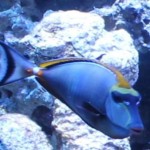
Blond Naso Tang
The below profile is on another one of the interesting tangs that I have kept. I have based this article on what I have learned and observed.
Common Name: Blonde Naso Tang, Elegant Tang, Orange spine surgeonfish, and Pacific Orangespine tang
Scientific Name: Naso elegans
Reef Safe: Yes
Temperament: Peaceful to semi-aggressive
Care Level: Moderate
Max Size: 16 to 18 inches (around 12 inches is more common)
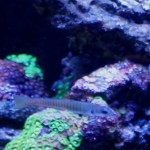
Zebra Barred Dartfish
The below Dartfish profile is based on what I have learned and observed while keeping these fish. They certainly are active little fish to keep and will add a lot of viewing pleasure to any aquarium.
Common Name: Zebra Barred Dartfish, Zebra Dart Goby, Bar Goby, Barred Dartfish, Zebra Goby, and Chinese Zebra Goby
Scientific Name: Ptereleotris zebra
Reef Safe: Yes
Temperament: Peaceful
Care Level: Easy
Max Size: 3 to 5 inches (around 4 inches is more common)
Appearance:
They are a small and comparatively long fish with a grey to green colored body and several black bars or stripes on them that have a very slight yellow to light green boarder on both edges of the black bars.
As you can well imagine, getting a good picture of a very small and fast moving fish can be a challenge for someone like me with limited photography skills, but the below are some pictures of my Zebra Dartfish
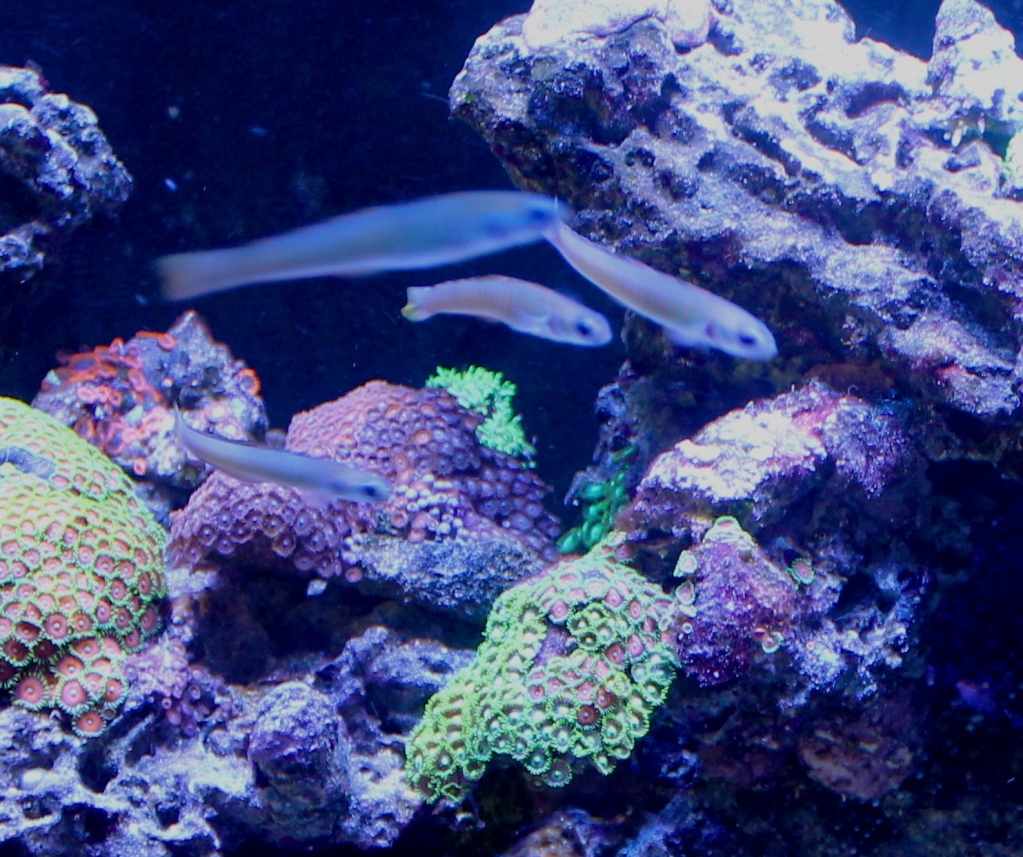
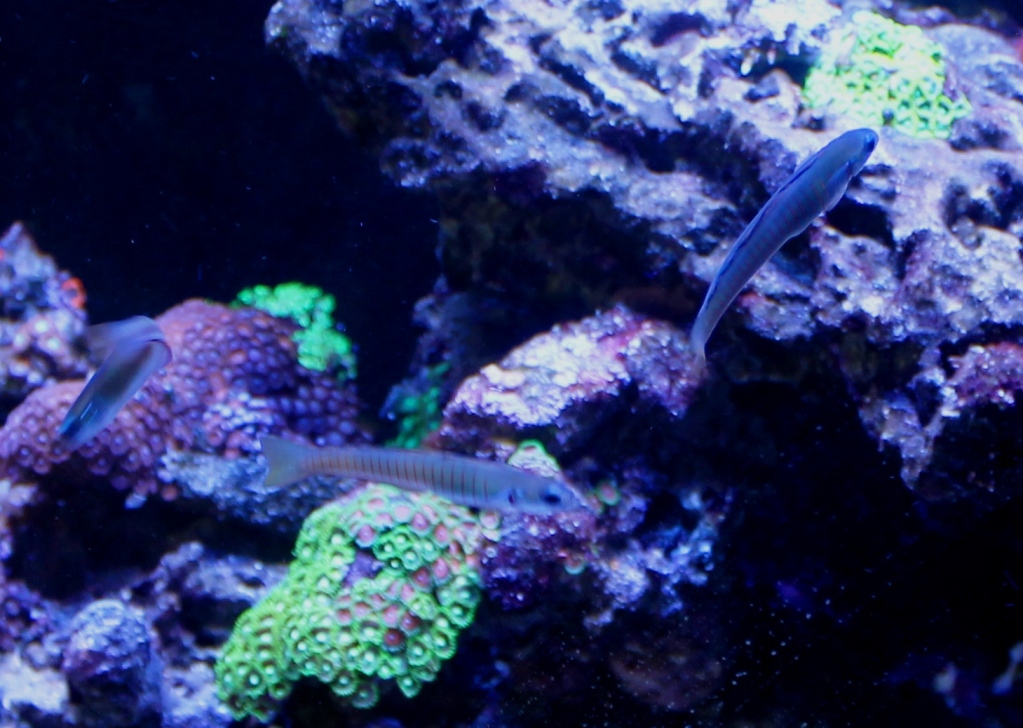
Temperament
Zebra Dartfish are great community fish. They are very peaceful and reef safe. They are very active and very fast swimmers and should be kept with other fish that will not get spooked by their activity level and fast movements of this Dartfish. They are a schooling fish so you will need to keep at least 6 of them together in the same tank. Based on my experience with them, they seem to do better when you have 8 or more which is why I would recommend keeping them in schools of 10. They work very well as dither fish potentially allowing other fish to feel more comfortable through seeing other fish swimming around in the aquarium.
Environment
Although this is a small fish, the Zebra Dartfish is a very active fish and should be kept in a 48 inch long tank to allow for the minimum amount of open swimming spaces which they typically need. You will also need to have some hiding spots for these fish to go to when they feel stressed or threatened. A lot of small hiding spots in your live rock throughout the aquarium will work best for these fish. Zebra Dartfish need a tank with a closed top as they have been known to jump out of the tank very often when kept in a open top tank.
Recommended water conditions:
I would refer you to the below article for the typical water conditions that a Zebra Dartfish will do best in:
https://www.reefaquarium.com/2013/the-basics-of-marine-aquarium-water-parameters/
Diet
Zebra Dartfish are carnivores. They will do best with a wide range of meaty foods like brine shrimp or mysis shrimp just to name two of them. Just make sure it is a food that is small enough for the Zebra Dartfish to get in its mouth. A good quality flake or proper sized pellet food for marine carnivores would also be a good option.
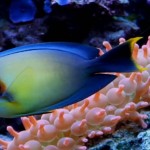
Mimic Tangs
The below profile is on one of the more interesting tangs that I have kept and is based on what I have learned and observed.
General Info:
Common Name: Mimic Tangs,
Scientific Name: Acanthurus Pyroferus (Yellow Mimic Tang), Acanthurus Tristis (Eibli Mimic Tang)
Reef Safe: Yes
Temperament: Can be Semi-Aggressive
Care Level: Easy to Moderate
Max Size: 10 in / 25 cm (7 to 8 inches is more common)